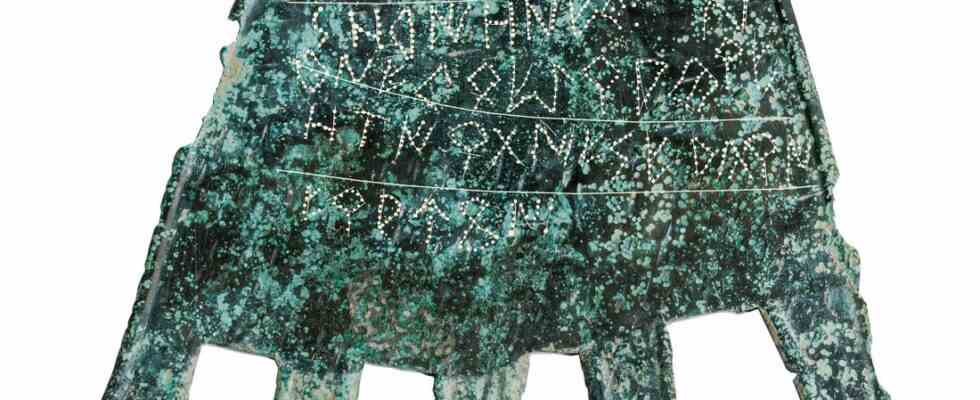What were the archaeologists thinking when they unearthed this hand in June 2021? A pretty thing, sure. A fine, gossamer-thin sheet of bronze in the shape of a human hand, circa 14 cm high and 13 cm wide, from the first century BC. As it probably once adorned a house, it will now enrich a museum as an expression of Iron Age art of the Vasconen tribe.
After the research team had freed the bronze artefact from the dirt of thousands of years, it was clear: this is not just art – this is a sensation. Five words had been scratched into four lines on the hand. The writing belonged to the Iberian system, but what language was it used to express? After the inscription was uncovered, a team of epigraphers and linguists pounced on the hand. They are now certain: the first written evidence of the Proto-Basque language is found on this bronze sheet.
“This piece turns our previous understanding of the Vascons and their writing on its head,” says Joaquín Gorrochategui, professor of Indo-European linguistics at the University of the Basque Country. “We were almost convinced that they were illiterate and only used characters to mint coins.”
The hand is apparently a lucky charm from the Iron Age
As the name suggests, the Vasconen are generally considered to be the ancestors of today’s Basques, and their area of settlement probably coincided geographically with today’s province of Navarra in Spain. The Basque language is considered the oldest isolated language on the continent, i.e. it is not related to other languages. The territory of the Vascones was incorporated into the Roman Empire during the first century BC. However, the Romanization was probably limited, as can be seen from the Basque culture and language that is still predominant today. Apart from a few mentions by Roman authors, there are no literary sources about the Vasconen, which is why it was assumed that they had no written form of expression for their language.
The current excavations, carried out since 2017 by the non-profit Aranzadi Science Society at the top of Mount Irulegi, have now proved otherwise. Here, near the Navarrese capital of Pamplona, there had been a Vasconian settlement since at least the eleventh century BC before it was burned during the Sertorian War (83-73 BC) during the Roman Civil Wars. The houses collapsed and buried the everyday objects of the Vasconen – today the settlement is therefore a treasure trove for archaeologists.
The location of the hand: a fortress near Pamplona.
(Photo: ARANZADI/REUTERS)
The bronze artefact now known as the “Hand of Irulegi” is by far the most important find made by the researchers. By deciphering the first word “sorioneku” the written form of the Vasconen could be proven at one stroke. The hand is therefore of inestimable value to linguists studying the origins of the Basque language. “This inscription is irrefutable,” says Javier Velaza, who was involved in the decipherment as a professor of Latin philology at the University of Barcelona. According to him, “sorioneku” is a precursor to the modern Basque word “zorioneko”.
“Zorioneko” can best be translated as “good luck” or “good omen”. The researchers therefore assume that the bronze hand was placed above the entrance to one of the mudbrick houses as a lucky charm. Unfortunately for the Vasconians of Irulegi, it was more than two millennia later that the hand became effective as a good luck charm.

